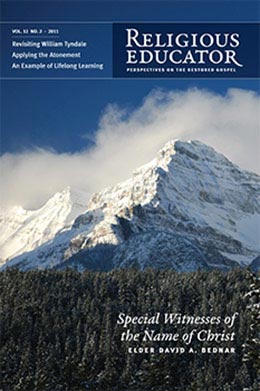Applying the Atonement of Jesus Christ
Brent L. Top and Brad Wilcox
A Conversation With Brent L. Top and Brad Wilcox, "Applying the Atonement," Religious Educator 12, no. 2 (2011): 35–45.
Brent L. Top (brent_top@byu.edu) was a professor of Church history and doctrine at Brigham Young University when this was written.
Brad Wilcox (brad_wilcox@byu.edu) was an associate professor of teacher education when this was written.
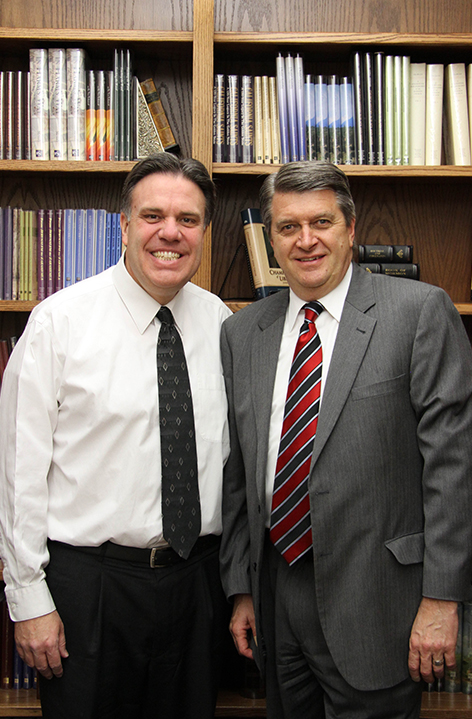 Brad Wilcox and Brent Top each wrote a book about how the Savior and the Atonement can help people in their everyday lives. Photo by Brent R. Nordgren
Brad Wilcox and Brent Top each wrote a book about how the Savior and the Atonement can help people in their everyday lives. Photo by Brent R. Nordgren
Religious Educator (RE): You have written the books The Continuous Atonement and When You Can’t Do It Alone. Both of you must have had personal experiences that gave you the ideas for these two books. Were you inspired by somebody in your family, an experience of your own, or something you witnessed? Why don’t we start with Brad [Wilcox]? What inspired you to write The Continuous Atonement?
Wilcox: The idea came to me when I was a bishop in a young single adult ward. I kept seeing so many young people experience great relief after confessing, doing what they were supposed to, and repenting. Then they would end up doing the same things again. They would come in again and again and then finally say, “I can’t do this. The scriptures say confess and forsake (see D&C 58:43). I confessed. I repented. I didn’t forsake, and so it’s over for me.” These were good returned missionaries; these were solid kids in the Church who knew enough to come and confess and were even willing to come and confess again. But after going through that process several times, they would finally just say, “Forget it.” I kept thinking that if the option is perfection or quitting, we are teaching this wrong. There has to be a way to teach people that there is a place for plodding along, for moving forward, for breaking bad habits, for making progress over time. People need to see that they don’t have to have everything taken care of before they can be worthy to pray and to go to church. I even had a young man tell me, “I’m not worthy to repent.” Something is wrong when you think you have to be worthy to repent. Obviously we need to share the message of the Atonement—the message of grace—in a more hopeful way. It isn’t presenting new doctrine. It’s figuring out how to teach the doctrine in a way that inspires hope instead of discouragement.
RE: Brent [Top], your book is called When You Can’t Do It Alone. What inspired you to write this book?
Top: For me it was a personal crisis, though I certainly never intended to write a book about it. It was only after the fact that I realized there were some things I had learned from my own difficult experiences that I felt could help others. The personal crisis came while I was serving as mission president. As Brad well knows, the pressure of the schedule, the endless problems, and trying to do everything right is immense. I remember feeling I was totally unprepared and not as spiritually strong as all the other mission presidents around me. Everything came crashing down one Sunday morning when I had a speaking assignment. I started having an anxiety attack, and I couldn’t get out of bed or bear the thought of one more thing to do; I just fell apart at the seams. I was surprised by that because I had always considered myself a relatively capable, conscientious person. I think it was the Lord’s way of saying to me, “The only way you are going to succeed as a mission president and in life is to quit trying to be everything to everyone. I just want you to do it my way.” At that point I crashed and said, “I can’t do this.” The thought of three years of not being able to do it, to use Alma’s words, brought me “inexpressible horror” (Alma 36:14). As I was crying in bed, my wife held me in her arms and said, “You can do this. Focus on Christ.” At that moment, I realized I had said those exact same words to students, to ward members, and to people I had worked with throughout the years, but at the moment of my own personal crisis I didn’t really know how to apply them to myself. I was like the man in Mark chapter 9 who asks the Savior to heal his son. The Savior says to him, “If thou canst believe, all things are possible.” The man says, “Lord, I believe; help thou mine unbelief” (vv. 23–24). At that moment I realized that during the thirty years of my Church education career I had been teaching about grace and faith. But now, faced with my own personal challenges, I had yet to learn how to really exercise faith. I still had not learned how to let the Savior lift me. The book came out of the practical, personal lessons in which I learned what it means to actually exercise faith. A wonderful statement from C. S. Lewis became even more meaningful. He said, “You will never know how much you believe something until it is a matter of life or death” (God in the Dock: Essays on Theology and Ethics, ed. Walter Hooper [Grand Rapids, MI: Eerdmans, 1970], 52). He compares faith to a string or a piece of twine that you would use to tie up a box. He said that it is one thing to say that your faith is strong if all you have to do is to take that piece of string and wrap it around a box, but you only really find out how strong the string is if you are hanging over a cliff holding onto it. That is what I had to find out. In a way, the book is about lessons I learned when the Lord forced me to my knees and said, “I’m going to help you now with your unbelief.”
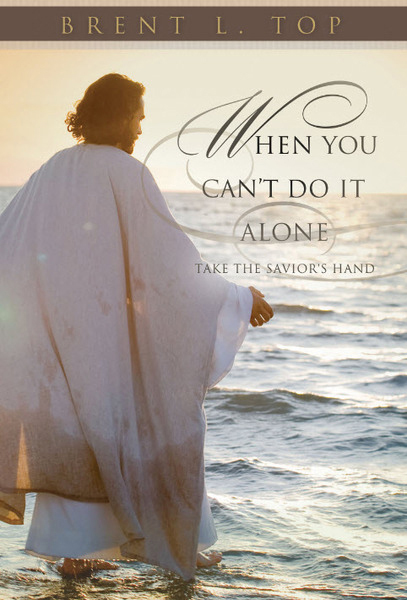
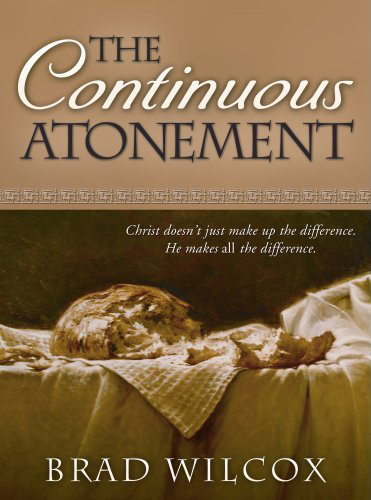 These books teach that Christ lives and how he can help people in their lives today.
These books teach that Christ lives and how he can help people in their lives today.
RE: Both of you are well-known teachers in the Church and are obviously well grounded in the scriptures. You have great ideas, and if you could write forever you could probably get all of your ideas out on paper. But to get these books down to a certain page length you had to distill your thinking. What did you gain from this process?
Wilcox: People sometimes believe that before you can write you have to have something to say. I don’t think that is correct. Sometimes you discover what you have to say in the act of writing. It is like when you are asked to give a sacrament meeting talk and are assigned a topic that you know nothing about. You panic! But then, all of a sudden, as you’re trying to prepare that talk you realize that you’re thinking and learning new things. I think writing is the same way. I don’t think that when I started writing this I thought, “Okay, here is what I’ve got figured out and now I want to share it.” I think the writing became the vehicle for me to figure it out. I didn’t know if I had anything to say until I started writing. Writing actually helped me to clarify my thinking and be more sensitive to the Spirit.
Top: Personally, I didn’t intend to write a book about the experience I mentioned. But then it became very clear to me that what I was experiencing was not unique. In almost every series of interviews, I would interview an elder or a sister who said, “I don’t think I can do this. This is so much harder than I thought it was going to be. I want to go home.” And I’d say, “I want to go home—I can’t do this either. But neither one of us can go home because the Lord has called us.” It was at that point that I realized that what the Lord was teaching me could also benefit others. Throughout the mission, I started to think about the lessons I had been learning and how they had helped me to put more trust in the Savior. So when we came home I thought, “I’m going to share my thoughts, feelings, and experiences.” This is when the book really started to come together. I don’t want this to sound too mystical, but the truth is that the concepts and titles of every single chapter came to me that very night. I had a notepad by the side of my bed, and the book was organized and outlined in a matter of minutes. Then as I sat down and started to write, scriptures and personal experiences would come to mind. So what did I get out of the writing? I am a totally different person in terms of my faith. I now understand what it means to take the Savior’s hand. I had been teaching others how to do it but had never really been forced to do it myself.
Wilcox: I was also changed by the writing experience. Preparing this manuscript has changed the way I pray, ponder, partake of the sacrament, and speak about the Savior. Even with the base of knowledge that we gather throughout all our experiences in the Church, it is only when we start trying to teach the gospel that we really start to live it on a higher level. I think that principle is an important one for all teachers. We all learn quickly that we are the ones who benefit the most; every religion teacher out there is learning just as much as any student is learning. Missionaries are being taught the gospel, but it’s not until they teach it with their own words and experiences that they suddenly internalize and value it. My life is different because of the experiences I shared in the book, but also because of the experience of producing the book. Several conferences back, President Henry B. Eyring talked about writing in a journal. He taught that one of the ways faith is increased and strengthened is by acknowledging the hand of God more in our lives (see “O Remember, Remember,” Ensign, November 2007, 66–69). That is one of the real benefits that came to me from writing the book. As I was writing and trying to get the things that I had experienced on paper, I would see more and more the hand of the Lord. I was able to connect the dots better because I was looking at a panoramic view of what God had done for me. I would begin to say, “Oh, now I understand that doctrine or that principle.” I began to delight in the scriptures, not just because I loved reading and discussing them but because I was teaching them.
RE: Let’s talk about the titles of your books. How did you choose your titles? Were they original or did the publishers choose them?
Wilcox: Many of the books that I have written have been titled by the publisher, but this one was my title and the subtitle was mine as well. I think that the publisher may have been hesitant to use the title because it seems so similar to Tad Callister’s The Infinite Atonement. There are a lot of words associated with the Atonement—infinite, eternal, everlasting, personal, incomprehensible—but continuous is a word that needs to be associated with the Atonement more. I’m glad that the editors let me keep that title because I think that it brings hope. One of the first reviewers of the book said that the Atonement is not continuous. He wrote, “Jesus Christ suffered, it’s over, it’s done. He doesn’t continually suffer when we sin.” Obviously the title was saying something different to him than I intended, but I think that for most people it has communicated what I wanted it to communicate: Christ’s Atonement is not just a one-shot deal. Christ’s grace isn’t limited in time to after all we can do. The enabling power is continuous. It’s not light at the end of the tunnel; it’s power throughout the entire journey. As Elder Bruce C. Hafen says, “We may receive his grace before, during, and after the time when we expend our own efforts” (The Broken Heart: Applying the Atonement to Life’s Experiences [Salt Lake City: Bookcraft, 1986], 155).
RE: Brent, you also have a great title—When You Can’t Do It Alone. Was that your title or the publisher’s?
Top: It was the publisher’s title, and I hated it at first. I’m pleased with it now, though. I originally entitled the book Focus on Christ because those were the words that my wife said to me when I was saying, “I can’t do it.” I initially didn’t like the title because it implied that we face trials alone. I didn’t like that implication.
Wilcox: When I read it, the implication that came to my mind is that too often we try to do it alone.
Top: That’s why the title works. There was a book a few years ago called Don’t Sweat the Small Stuff . . . And It’s All Small Stuff. I would have liked my book to be called When You Can’t Do It Alone . . . And in Reality You Never Can Do It Alone. But with the wonderful photograph from Mark Mabry on the cover, it really appeals to me now. It reminds me of the scripture in Matthew chapter 14 where Peter says to the Savior, “Lord, if it be thou, bid me come unto thee on the water” (v. 28). And as Peter walks to him on the water, the wind and the waves bash against him and he begins to doubt. Because he takes his focus off Christ, he falls, crying out, “Lord save me” (v. 30). I think the image of Peter walking on the waves arm-in-arm with Christ by his side is beautiful. We are all going to have those moments where we say, “I’m sinking; Lord, save me,” and we have to take the hand of the Savior.
RE: When all is said and done, what is the central message that you would hope everybody who reads your book understands?
Top: I want people to learn that there’s nothing wrong with you when you feel like you are sinking, because the Lord actually wants to teach us to take his hand and to rely on him. We are all going to have those sinking moments so that we can learn greater faith. What I want my reader to gain is that there are some very simple, practical things that we can do each day that help us to take hold of the Savior’s hand of grace. For instance, singing the hymns focuses our minds on the Savior. Years ago, President Boyd K. Packer told us to sing a hymn when we had bad thoughts. But, in reality, singing a hymn not only helps us to avoid bad thoughts, it also gives us those enabling, empowering thoughts of Christ. I hope that readers will realize that the Savior’s hand is there and that they can take it every single day.
Wilcox: I think the message of my book is that the Atonement is real, its purpose is to transform us, and it will be there as long as that transformation process takes—even continuously. We need to cut ourselves a little slack as we go through this perfecting process. I hope people will come away from my book no longer talking about “his part” and “my part.” I think too often in the Church you hear people say, “Well, you’ve got to meet God halfway.” At one point in the book, I talk about how too often we see Christ’s grace supplementing our works or our works supplementing Christ’s grace as if we are trying to reach some type of minimum height requirement. Instead we need to think a little less about height and a little bit more about growth. We need to think a little less about this ratio of “his part” to “our part” and think more about how we are in a relationship that is greater than the sum of the parts. Is there something that we have to do? Yes. Christ does require that we have faith, repent, make covenants, receive the gift of the Holy Ghost, and endure to the end. There are things that are being required of us, but not because we somehow must pay Jesus back. Instead, these things help us to feel grateful for and use the opportunities that Christ gives to be transformed. The requirements that we sometimes think are way too much to ask are not being required as any sort of full or partial payment; they are being required for our own good—to change us. Jesus, who paid justice, can and does ask something of us, but he asks it for a different purpose than punishment or payment. It’s the difference between paying off debt and making an investment. It’s the difference between walking on a treadmill and really getting somewhere. Once you understand that, it gives a whole different perspective to everything.
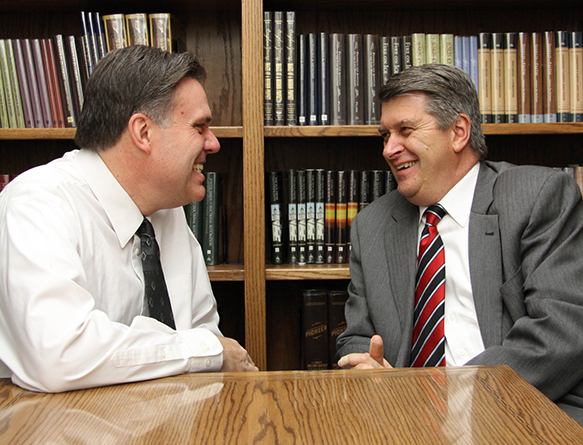 "It was a moment of great inspiration for me when I saw that grabbing the iron rod is like grasping the arm of Christ." Photo by Brent R. Nordgren
"It was a moment of great inspiration for me when I saw that grabbing the iron rod is like grasping the arm of Christ." Photo by Brent R. Nordgren
RE: Would you share with us something that you have learned from each other?
Wilcox: I have loved Brent’s Doctrinal Commentary on the Book of Mormon. That series has been extremely impactful for me, and I quote Brent in my book. I have also read When You Can’t Do It Alone. I love his image of the iron rod as the arm of Christ. I had never thought about the verse, “The iron rod . . . was the word of God” (1 Nephi 11:25) in conjunction with the scripture, “And the Word was made flesh” (John 1:14). It was a moment of great inspiration for me when I saw that grabbing the iron rod is like grasping the arm of Christ.
Top: I remember the first time I read Brad’s Continuous Atonement I was sitting on an airplane and read it cover to cover during the three-or-four-hour flight. I liked not only the repentance part but also the part about changing our lives and habits. He gives a humorous list of excuses we use and that made me smile. I really liked the difference he explains between saving and redeeming: I think this section is really helpful because it does not just focus on overcoming sins but also talks about finding the strength to make it through each day. So many people outside the Church condemn us because they think that we believe we can work our way to heaven. They jump on little phrases that we use a lot in Latter-day Saint culture and say that we do not understand grace. I think that both of these books will not simply clarify our beliefs on grace for members of the Church but also for those who are not of our faith. As Brad says in his book, a born-again friend often asked him, “Have you been saved by grace?” He said, “Yes, I have. Completely. Absolutely. Totally.” And then he added with a wink, “Have you been changed by grace? Have you been transformed by grace?” I think sometimes they get so excited about being saved by grace that they don’t realize there is a little bit more to Jesus’ gift.
RE: Evangelicals did a study on how many kids really are living the law of chastity and how many are honest on their tests. They discovered there are a lot of evangelicals who can tell you the day they were saved but don’t live lives that reflect that. Do we struggle in the same way?
Top: I’m sure many young Latter-day Saints have similar struggles, but I think that we sometimes do the opposite. We take 2 Nephi 25:23, “We are saved by grace, after all we can do,” and we create this image of Christ as the Lord of the gap. Robert L. Millet emphasizes that grace is not about filling a gap. Jesus already filled the gap. Grace is now about filling us. Jesus is concerned with making us more like him, more like our Heavenly Father, and more able to continue to grow in the eternities. But because it is such a common way of teaching grace in the Church—Jesus making up the difference—that people don’t stop to realize that there are other ways to think of it.
RE: Sometimes we go to general conference or read the Ensign and we take the teachings and put them into our own preconceived frameworks. But from the beginning grace has always been a vital doctrine of the gospel. The question is how do we find what is already there? How do we change our perspective and adopt a different view that gets us closer to finding the meaning of the text?
Wilcox: If you read the Book of Mormon, grace is clearly there. I think we simply get scared of falling into the extreme of saying, “Nothing matters, I’m saved. I don’t have to do anything.” Instead, we need to say, “Yes, I’ve been saved, and now it’s time to focus on what I’ve been saved for—to become more like Christ.” Hopefully, these books are helping members of the Church to see that we’re not beating the drum for works or the drum for grace. We’re beating a drum that says there is a little more to both grace and works than paying our debt. I like to compare the Savior’s relationship with us to a mom offering a young child piano lessons. Mom pays the piano teacher and is therefore in a position to ask the child to practice. The child is missing something if he is just happy the debt is paid by someone else. Mom wants the child to practice and improve. Because that practicing is hard, sometimes the child says, “I don’t understand why I have to practice.” That’s just because he lacks Mom’s perspective. Does the child’s practice pay the piano teacher? Does it pay Mom back for paying the bill? No. Practicing is how the child takes advantage of what Mom is offering—the opportunity to live on a higher plane.
Top: In Latter-day Saint contexts, when we speak of the Atonement the first thing that pops into our minds is forgiveness of sins. Personally, I have been forgiven; I have felt the love of Christ cleanse me from my sins. I think that both these books point out that forgiveness of sins is truly a part of grace, but another part of the Atonement, a part that most of us neglect, is empowerment. Grace is strength. When I wrote my book, I started to understand better than ever what the Apostle Paul meant when he talked about the strength of Christ and being able to do all things through Christ (see Philippians 4:13). I need grace every moment of every day, not just to overcome sins. I need grace to give me strength to resist temptation, strength to endure, strength to exercise greater faith. As I take hold of the Savior’s hand, I am infused with power. In the book I talk about Lehi’s vision in a chapter entitled “Hold On.” I talk about how you do not see people in Lehi’s dream make it to the tree of life or partake of the fruit without holding on to the iron rod. It does not matter how good their sense of direction is or how good their pressing forward is or how strong their desire is—the only way they make it is by holding on to Christ.
Wilcox: Ultimately, the only way that we will pass through the veil that stands between us and the celestial kingdom, between our current states and all the possibilities that await there, is by holding on to Christ. Nobody appears at the veil and can just go in alone. Everyone goes through with Christ. The miracle of the Atonement is not just its power to cleanse and not just its power to console us during hard times or sicknesses. The miracle of the Atonement is also its power to transform—not only can we go home to God’s presence, but we can feel at home there.
RE: There is a passage in Psalm 73 about a faithful Israelite who has been observing the wickedness of the rich. He says, “Even after everything I’ve done, I am plagued.” But then he goes to the house of the Lord and says, “I went into the sanctuary of God; then understood I their [fate]” (v. 17). He ends by saying, “Nevertheless I am continually with thee: thou hast holden me by my right hand. Thou shalt guide me with thy counsel, and afterward receive me to glory” (vv. 23–24). The idea of holding the Savior’s hand is quite explicit in those verses.
Top: Yes, there is also a wonderful passage in Isaiah 41 where the Savior says, “I, the Lord God, will hold thy right hand” (v. 13), and that is why I think the imagery is so beautiful. Personally, one of the things that this whole experience did for me is that it made me a different person. I was strengthened. Interestingly, not long after I got home from being a mission president, I was called to be a stake president; I knew exactly what was going to happen. As we were walking up the stairs to the stake center, I told Wendy, my wife, “This feels a lot like when I was walking up the stairs to President Monson’s office and was falling apart at the seams wondering how I could ever do this.” And Wendy said to me, “But now you know that the Lord will keep his promise and be with you.” Now, as I serve as a stake president, there are still problems and pressure. I am approaching it totally differently, though, because of what I learned and what I experienced.
In the preface to my book, I explain that I was very reluctant to share my own experiences. In fact, there were some people who said, “Brother Top, you may not want to be that honest because it could make you look weak.” I told them that that was the point. I want this book to make me look weak in myself but strong in Christ. The thing that has been most gratifying to me is that there are people who will write to me or call me and say, “I thought I was the only one feeling this. I thought I was the only one. And now I know that even someone in your position goes through some of these challenges.” It gives them hope because it shows that the Atonement is real and that they truly can trust in the Lord. People who struggle with problems and challenges often say, “I believe that the Atonement is for someone else.” It was wonderful to hear people say, “Now I know it is for me.” I got an e-mail just the other day from a mission president who had just read the book, and he said that it had helped him. All of us look at other people and say, “They have got it together. I’m the only one who doesn’t have it together.” Of course, I would not want, through my book or my other writings, to hold myself up as some role model or example. That is not the intent. I have been very open in sharing the insights that I have learned because it transformed me so profoundly. I am so incredibly grateful for the hardships that I had to go through. They forced me to my knees, and that forced me to the Lord.
Wilcox: I think a message of these books is that none of us are alone. There are others who have struggled over and over and over with some of the same problems and God and Christ are there. The message is the same to everyone: hang on, don’t ever give up. Don’t ever lose hope.
